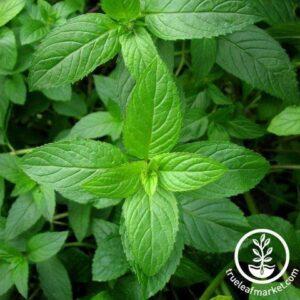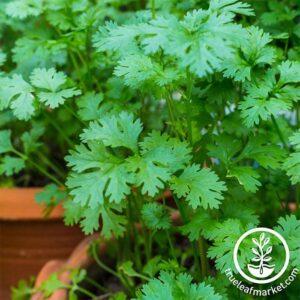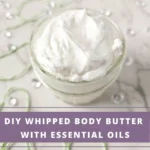As an Amazon Associate I earn from qualifying purchases. See Full Disclosure Here
There’s nothing quite like adding fresh herbs to your food at any time of the year. Fresh herbs add taste and health benefits to any dish, from soups and salads to fish and poultry dishes and even savory baked items. One of the biggest benefits of adding herbs to your diet is that they add flavor and health without adding any unwanted calories. Win-win!
Herbs are particularly useful during the cold winter months. In addition to adding flavor to your hearty soups and stews, all herbs pack a mighty nutrient punch. Parsley is rich in vitamins A and C, while Rosemary contains several B-complex vitamins. Many herbs are rich in antioxidants. Adding a small amount to your dishes will give your winter health a much-needed boost.
Fortunately, there are quite a few herbs you can grow in winter so you don’t have to make do with the dried variety. If herb gardening is on your mind this winter, consider growing the herbs mentioned below.
The Best Way to Start Your Indoor Winter Herb Garden – Use a Herb Gardening Kit
 A quick note before getting down to discussing the best herbs to grow in winter. The best way to get started with your winter herb garden is with an indoor herb starter kit. This is especially convenient if this is your first attempt at growing herbs.
A quick note before getting down to discussing the best herbs to grow in winter. The best way to get started with your winter herb garden is with an indoor herb starter kit. This is especially convenient if this is your first attempt at growing herbs.
Indoor herb starter kits are relatively inexpensive and they contain everything you need to get started, from the container and soil to the seeds and all the accessories you need to grow your herbs. These are the best indoor herb gardening kits based on ease of use, brand reputation, and value for money. You’ll find it super easy and convenient to start your indoor herb garden using any of the herb gardening kits you’ll find listed on the page.
Indoor gardening kits also make fantastic gifts for family and friends who may not have the space, time, or ability to start a large outdoor garden. These Pretty and Practical Gardening Gifts make it easy for anyone to get started with gardening and they look good enough to keep on the kitchen countertop or the windowsill.
The best part about using an indoor herb gardening kit is that you can grow herbs indoors all year long and the kits themselves look good enough to keep on your kitchen window sill or kitchen slab.
If an herb starter kit is not part of your winter herb garden plans, you can buy seeds for individual herb plants from True Leaf Market or Amazon. Both are excellent resources for buying herb seed packets and herb growing starter kits.
These are the best herbs to grow in winter
1. Thyme
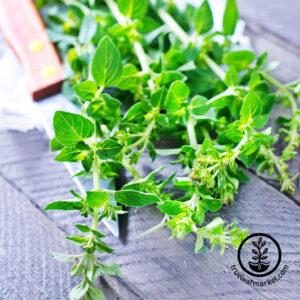 Thyme is a true winter plant. It thrives in lower temperatures. The cold is in fact an integral part of the natural life cycle of the thyme. The plant is far less likely to reach full maturity if planted in the warmer months. Your indoor thyme shrub will survive and thrive over winter with little or no maintenance.
Thyme is a true winter plant. It thrives in lower temperatures. The cold is in fact an integral part of the natural life cycle of the thyme. The plant is far less likely to reach full maturity if planted in the warmer months. Your indoor thyme shrub will survive and thrive over winter with little or no maintenance.
When harvesting, snip off as many stalks as you need a little above the base and strip the leaves into your dish. When snipping the stalks, make sure to leave behind some of the plant’s old growth. The older growth acts as the plant’s reserves, facilitating the growth of new leaves.
Thyme serves both medicinal and culinary purposes. It is a great accompaniment to pork, pasta, and hearty beef stews. Several studies suggest that thyme oil can improve digestion, reduce inflammation, and decrease airway constriction.
Useful Read: How To Grow Thyme Herb From Seed
2. Rosemary
 Rosemary is a perennial herb with a woody consistency. It thrives all year round and is robust enough to withstand even icy temperatures. It takes very little to grow rosemary. The plant doesn’t require a lot of maintenance, and nor does it require a lot of water. Just plant it and leave it. A quick check-in every few days is good.
Rosemary is a perennial herb with a woody consistency. It thrives all year round and is robust enough to withstand even icy temperatures. It takes very little to grow rosemary. The plant doesn’t require a lot of maintenance, and nor does it require a lot of water. Just plant it and leave it. A quick check-in every few days is good.
Rosemary seeds grow into a beautiful aromatic bush. It is often also used as an aromatic, ornamental plant. When your Rosemary plant has grown sufficiently, prune it slowly into a Christmas tree shape to create an edible decoration ready for the Holidays.
To harvest rosemary, snip back as many stalks as you need to use in your dish. Rosemary can be harvested throughout the year and pairs well with heartier winter dishes such as beef and lamb. Its strong flavor stands up well to the pungent flavors of other herbs such as garlic, so neither one is overshadowed in the dish.
For a soothing homegrown and home-brewed winter tea, steep whole fresh stalks in water for a few minutes. Sip the warm rosemary-flavored water. This herb is fantastic for boosting digestion, managing stress headaches, and maintaining overall health.
3. Basil
 Tasty, healthy, and versatile, basil is one of the most popular herbs around the world. It adds subtle flavor and heaps of goodness when added to any dish. Basil leaves are a key addition to almost all Italian dishes from soups and sauces to pizzas and pesto.
Tasty, healthy, and versatile, basil is one of the most popular herbs around the world. It adds subtle flavor and heaps of goodness when added to any dish. Basil leaves are a key addition to almost all Italian dishes from soups and sauces to pizzas and pesto.
The plant grows well indoors and the leaves can be picked regularly without fear of inhibiting future growth.
To harvest basil leaves, pinch off bunches of large leaves with your fingers right above the new growth at the point where you see two sets of new leaves growing. Each of these sets will push out new stalks and leaves. As these grow, pinch them off the same way as above. In time, you will have a bushy, full basil plant. Be sure to trim off any long, leaf-less stalks, as they can cause rot if left on the plants
Basil is high in potassium, calcium, and vitamins K and A. It is also packed with antioxidants and antibacterial properties. Studies have shown that basil reduces inflammation, improves cardiovascular health, and inhibits the growth of bad bacteria.
The interesting thing about the basil plant is that it exists in so many varieties. This is why almost every culture has its own ‘Basil identity’. You’ll find seeds in almost every basil variety in this Basil Seed Collection.
4. Tarragon
 Tarragon is one of the best herbs to grow indoors in winter.
Tarragon is one of the best herbs to grow indoors in winter.
This herb is known for having a longer period of growth and maturing during the colder months. The plant looks like a scraggly mess of mostly roots and stalks during the fall but springs to life during the winter months.
To give your tarragon plants an extra boost, place them in the coldest spot in your home. Do this for around 3 – 4 days, then take the plant and place it in a spot that gets an abundance of natural light. A sunroom, patio, and a window that gets a lot of sunlight are ideal spots.
Avoid using any type of chemical fertilizer for your tarragon plant. This herb thrives with natural and organic fertilizer. Try using liquid fertilizer for good coverage and great results.
5. Mint
A tough, resilient plant, Mint grows well in any weather, including winter. The thing to remember about planting mint is that it grows like a weed. It grows fast and spreads just as fast. You’ll never be short of mint with your own plant.
Plant mint with other herbs and it is will take over the entire planter and crowd out the other herbs. To avoid this, plant mint in a separate pot. Plants like mint can be harvested in small amounts without killing the plant as long as you leave enough of the plant to grow new branches and leave in the future.
Mint is chock full of Vitamin C and iron, which makes it a great herb to have plenty of during winter. It has powerful immune-boosting properties and also helps fight fungal infections that threaten the body. Studies have shown that ingesting and smelling freshly cut mint can help soothe anxiety and promote calmness and serenity.
6. Parsley
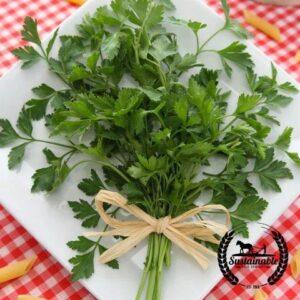 Just as hardy as mint, Parsley can grow in a wide range of climatic conditions and can withstand even harsh winters. The growth does slow down at the peak of winter. If you like using a lot of parsley in winter, make sure you grow extra plants to make up for the slower growth.
Just as hardy as mint, Parsley can grow in a wide range of climatic conditions and can withstand even harsh winters. The growth does slow down at the peak of winter. If you like using a lot of parsley in winter, make sure you grow extra plants to make up for the slower growth.
This herb plant self-seeds, which means you don’t have to worry about planting new seeds after every season. This self-seeding plant will grow even if you don’t plant new seeds.
Parsley is more than a popular garnish. This herb plays an important role in the digestive process. It contains substances that act as the first line of defense against stomach issues, acid reflux, and other digestive conditions.
You’ll find seeds for different types of Parsley here.
7. Sage
 Although Sage is a perennial, it is one of the more difficult herbs to grow in winter. This is because it needs slightly more attention as compared to most other winter herbs.
Although Sage is a perennial, it is one of the more difficult herbs to grow in winter. This is because it needs slightly more attention as compared to most other winter herbs.
The plant needs a fair amount of direct natural light to thrive. During the cold winter months, the growth of sage slows down a bit to preserve energy for the harsh weather conditions. A carefully balanced watering schedule is of paramount importance because too much or too little water will kill a sage plant.
The leaves add a fragrant scent and robust flavor to soups, stews, and warm winter teas.
Sage leaves make a very effective cough suppressant. Steep freshly plucked sage in boiling water for 15-20 minutes. Strain out the leaves. When the concoction has cooled down sufficiently, use it to gargle. Adding a small bit of smashed ginger makes this cough suppressant even more effective.
8. Cilantro
Cilantro grows easily and abundantly and requires very little maintenance. The seeds grow best in cooler temperatures. They do take a few weeks to germinate so make sure you plant them early.
This herb is best used fresh. It tends to lose its flavor and medicinal properties when left too long between harvesting and using.
A strong, flavorful, fresh-tasting herb with powerful health benefits, Cilantro is a wonderful addition to your kitchen herb garden! The entire herb is edible. Cilantro is a popular addition to a wide range of global cuisines, especially Mexican and Indian. Sprinkling freshly plucked and cut cilantro leaves over any dish to give it a unique flavor and taste.
If you love making your own salsa or you enjoy cooking Mexican dishes at home, this Mexican Salsa Seed Starter Kit Is a must-have. The Mexican Salsa Starter Kit includes a Beautiful Giftable Box, trays, humidity dome, seed label sticks, compressed soil pucks (just add water), easy-to-follow instructions, and an assortment of salsa garden seeds (enough for multiple plantings).
9. Lavender
 Lavender is a hugely popular herb with beautiful, aromatic purple flowers. The flowers are used for culinary, medicinal, herbal tea, and ornamental applications. Lavender seeds will grow into a perennial bushy, aromatic plant.
Lavender is a hugely popular herb with beautiful, aromatic purple flowers. The flowers are used for culinary, medicinal, herbal tea, and ornamental applications. Lavender seeds will grow into a perennial bushy, aromatic plant.
The plant doesn’t need very frequent watering, but the soil must have adequate drainage to prevent mold and other excess water issues. Lavender flowers around the spring and remains in bloom until summer, so it should be planted in the fall. You can also grow some smaller plants that you can keep indoors for part of the day for their clean air properties.
Lavender is used for its aroma and therapeutic properties in several different homemade products from bath and body care products to candles, fragrances, and teas. Lavender’s aroma is associated with relaxation and stress relief.
10. Hyssop
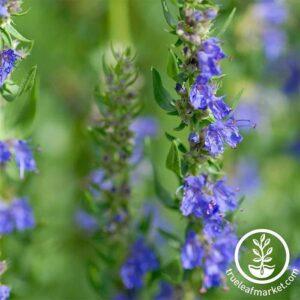 Hyssop is a perennial herb. This short, bushy herb is related to mint and has a similar flavor. It handles relatively cold temperatures pretty well and is a good herb to grow in winter.
Hyssop is a perennial herb. This short, bushy herb is related to mint and has a similar flavor. It handles relatively cold temperatures pretty well and is a good herb to grow in winter.
The blue flowers of the hyssop plant can be used to make infusions for relief from minor illnesses. Add freshly cut hyssop leaves to tea for effective throat care. Hyssop tea is an excellent expectorant. It acts by reducing mucus thickness.
Hyssop is an ancient herb used for medicinal, culinary, and ceremonial purposes. It has a strong minty flavor and can be used sparingly as a flavoring for food and herbal teas. Ingesting more concentrated forms of hyssop can help combat issues with breathing, as it helps with inflammation and the dilation of parts of the lungs. Hyssop also helps lower blood pressure.
11. Chives
 Chives can be grown indoors right through winter. With their slender stalks and delicate purple flowers, they add a lovely decorative and aromatic touch to your indoor ambiance.
Chives can be grown indoors right through winter. With their slender stalks and delicate purple flowers, they add a lovely decorative and aromatic touch to your indoor ambiance.
To harvest, snip off bunches close to the base of the plant with scissors. If the chives stop producing new growth, put the pot in a dark closet for a few weeks, then bring it back to the sunny window. This should help it spring back to life.
Sprinkle freshly harvested, freshly cut chives over salads, bakes potatoes, omelets, savory muffins, and soups. The purple flowers that chives produce are edible and add a garlicky flavor and crunchy texture to any salad.
These Chive Seeds are perfect for planting indoors in winter.
12. Chervil
 Chervil is an annual herb that has a parsley flavor with a hint of a tarragon taste. The plant grows up to two feet tall and has small white flowers when it blooms. It’s commonly used for its medicinal properties.
Chervil is an annual herb that has a parsley flavor with a hint of a tarragon taste. The plant grows up to two feet tall and has small white flowers when it blooms. It’s commonly used for its medicinal properties.
Ths strong aroma of the herb makes it great for flavoring hearty winter soups and stews.
Chervil is great for soothing sunburns and also acts as a natural disinfectant. Take some fresh chervil leaves, smash them into a rough paste and either apply directly to scrapes, burns, and minor cuts.
BEST PLACE TO BUY HERB SEEDS OR STARTER PLANTS & ENJOY GREAT SAVINGS TOO!
Before talking about the best herbs to grow in winter, I wanted to introduce you to True Leaf Market. Browsing through this online gardening store is like going to an ice-cream parlor – the biggest problem is not giving in to the temptation to get more than you need.
True Leaf Market is hands down the best place to get everything you need to start your herb garden in winter or any time of the year. They have it all, from herb, vegetable, flower, and cover crop seeds to planters, growing trays, grow medium, fertilizer, grow lights, and compost bins.
If this is the first time you’re growing herbs from seeds, a good place to start is their free ebook ‘How To Grow Herbs From Seeds‘. It contains a wealth of information aimed at helping you make informed choices when creating your winter herb garden.
Other interesting items you’ll find at the True Leaf Market Online Store to help you get started with your herb garden:
Stack And Grow Stackable Planters – These are brilliant for vertical gardening in smaller spaces. You’ll find these planters in different designs and capacities, including hanging stackable planters and larger ones designed to hold 20 herbs. They come in natural colors including terracotta and sand and can be used indoors as well as outdoors.
Barnwood Style Planter Box – If you like the look of antique distressed wood, you’ll love the Barnwood Style Planter Box. It is made from Western Red Cedar and measures 15″ x 6.5″ and is 3.5″ deep. It comes with a clear drip tray to drain off excess water. You can buy the Barnwood Style Planter Box by itself or as a herb garden kit complete with compressed soil and a selection of 4 certified organic, non-GMO herb seeds. The kit includes seeds for Cilantro, Basil, Oregano & Sage, all of which are great herbs to grow in winter. There’s also a handy instruction book included in the kit.
Mountain Valley Seed Co. Culinary Herb Seed Starter Kit – This is available in Basic, Premium, and Deluxe options. The only differences between the three versions are the number of drip trays and seed varieties that are included. All the herb seed starter kids come in a beautiful giftable box and include Cell Seed Trays, Herb Seeds for multiple plantings, a Humidity Done, and Seed Label Sticks.
Culinary Herb Assorted Seed Pack – This seed pack includes an interesting assortment of non-GMO culinary herbs to grow indoors or outdoors. It includes 12 herb garden seed types: Parsley, Thyme, Cilantro/Coriander, Basil, Dill, Oregano, Mint, Chives, Savory, Garlic Chives, Mustard, Sage. Almost all of these herbs can be grown in winter.
You don’t have to compromise and use dried herbs in winter. Choose one of these indoor herb starter kits or go directly to True Leaf Market and buy the supplies you need to start growing your own herb garden in less than a week. You won’t have to wait too long after that to be rewarded with fresh herbs that will add flavor and nutrition to all your dishes throughout the year.
What other herbs have you tried growing during winter? Did you use an indoor herb growing kit or did you get the seeds? Let us know how your herb plants turned out.

Disclaimer: This information is not intended to serve as medical advice. Please consult your doctor before using any natural medication or if you experience any unusual symptoms. Read Full Disclaimer here.

